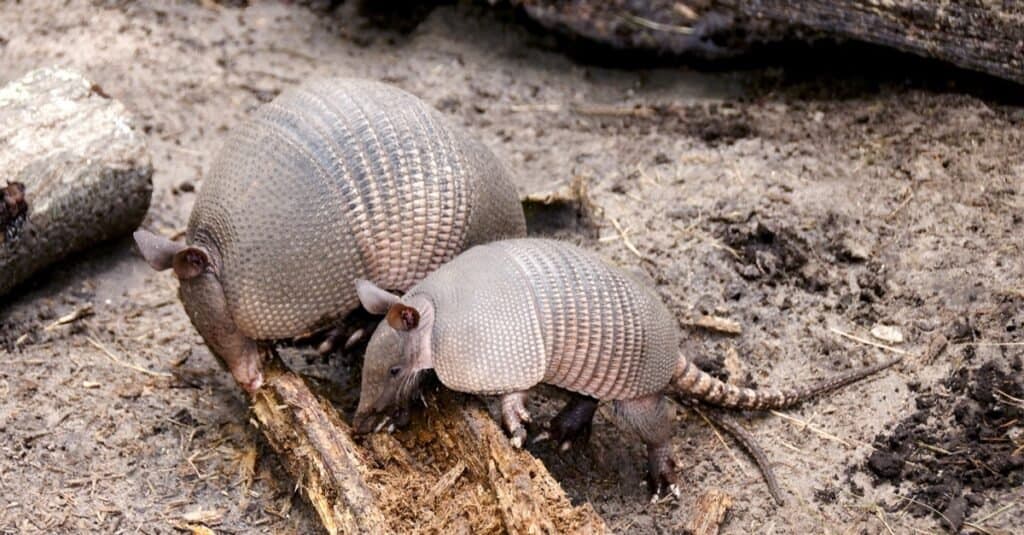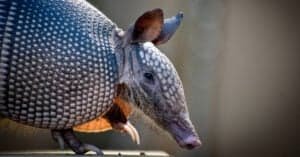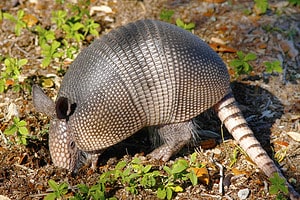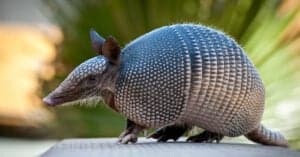Nature makes many odd creatures, but one of the strangest on earth must be the armadillo. This animal looks like it’s wearing a suit of armor, and its name means “little armored one.” Some people think armadillos are amphibians or reptiles, but they’re not. They’re mammals.
5 Amazing Facts About Armadillos
- Armadillos eat many insects, including fire ants.
- Only the three-banded armadillo and Brazilian armadillo curl up into armored balls when they’re threatened.
- They can run up to 30 miles an hour.
- Armadillos are excellent swimmers and can hold their breath underwater.
What Is a Mammal?
Backbone: Every mammal is a vertebrate, which is an animal with a backbone. Other animals have backbones, but they don’t meet the other criteria for mammals.
Fur or hair: All mammals have fur or hair on their skin. Some marine mammals have no hair, but they meet the other requirements to be mammals.
Sweat glands: Mammals are the only animals that sweat. The ability to sweat helps mammals regulate their body temperature. Some marine mammals don’t have sweat glands because they live in the ocean.
Live young: Only mammals give birth to live young. They also nurse their young. Monotremes are the only exception to this rule. They’re mammals who lay eggs but also nurse their young.
Occipital condyles: This is the scientific name for two bony knobs at the base of an animal’s skull. Only mammals have them. Reptiles and fish have a single knob on their skull.
Now, let’s see how an armadillo compares to that list.

©iStock.com/6381380
Do Armadillos Have These Characteristics?
Backbone: An armadillo is a vertebrate.
Fur or hair: This is where it gets confusing. The armadillo is covered in a tough, scaly coat of armor that doesn’t seem like fur or hair. In fact, it is made from keratin, which is one component of hair, horns, and fingernails. An armadillo’s shell starts out soft. As it grows, the shell hardens.
Sweat glands: Armadillos have sweat glands, and they use various methods to regulate their body temperatures.
Live young: Armadillos give birth to live young. They typically have large litters of up to 15 baby armadillos. Their babies are called pups, and twin births are common.
Occipital condyles: You can’t see them under all that armor, but they’re there.
The evidence is clear. Armadillos are mammals.
How Many Armadillo Types Are There?
There are 21 species of armadillo. Only the nine-banded armadillo lives in the U.S. Other species include:
- Seven-banded armadillo.
- Pink fairy armadillo.
- Screaming hairy armadillo.
- Long-nosed armadillo.
- Giant brown armadillo.
Most armadillos are fairly large and come in earth-toned colors of gray, black, and brown. The pink fairy armadillo, however, stands out for its tiny size and bright color. It is a tiny creature that’s about six inches long, and its shell is a bright pink color.
The giant brown armadillo is the largest member of the family. It can be 5 feet long. The screaming hairy armadillo gets its name from its shaggy armor and its loud, piercing calls.
Are They Reptiles?
It’s easy to see why some people might think they’re reptiles. That tough, scaly hide looks like something a crocodile or lizard might have.
Reptiles are not mammals, even though they share some characteristics with mammals, like a backbone. On other counts, however, they miss the mark. They don’t give birth to live young, they don’t nurse their offspring, and they are cold-blooded rather than warm-blooded.
Armadillos are not reptiles.

©Rose Waddell/Shutterstock.com
Are They Pangolins?
The pangolin also has an armored body and a fondness for eating insects. Also known as the scaly anteater, it resembles the armadillo in size and shape.
Biologists originally thought these armored mammals were related, but now, they class pangolins in a separate category. These animals are native to different regions of the world. Pangolins live in Asia and Africa, and armadillos live in the southwestern part of the U.S.
Are They Rodents?
Armadillos are not rodents. Some species of flying squirrel are described as “scaly tailed,” but there the resemblance ends. Rodents have sharp incisors and a fondness for nuts and seeds. Armadillos don’t have these traits.
They’re Not Marsupials, Either
Armadillos are sometimes mistaken for opossums because they’re a similar size. Opossums carry their young in a pouch and are the only marsupial native to the U.S.
Where Do Armadillos Live?
Armadillos live in nests called burrows. They dig out these nests using their short legs and tough claws. These tough guys prefer living on loose, loamy, or soft soil that is easy to dig.
They often create several burrows all over their territory. They like to slip inside their underground caves to cool off on hot days.
Armadillos Are Mammals
Like rabbits, lynxes, panda bears, and humans, armadillos are members of the mammal family. These burrowing beasts may have scales, but they fit all the other criteria of mammals.
They are also the only other mammal besides humans that can carry leprosy. This is probably due to the fact humans and armadillos have a similar internal body temperature. Contacting leprosy from Armadillos is extremely rare and even believed to have been originally transmitted to them centuries ago from humans!
Up Next:
- Armadillo Want more information? Find out all you want to know about this interesting animal.
- Animals in Texas The Lone Star state has some great hats, great music, and great wildlife. Read to find out more!
- Tortoise Slow and steady wins the race! These ancient reptiles go about life at their own pace.
The photo featured at the top of this post is © iStock.com/Rini Kools
FAQs (Frequently Asked Questions)
Is it true that armadillos are deaf and blind?
They have poor hearing and sight, but they are not blind or deaf. They rely on their sense of smell, which is very strong.
Are they dangerous to humans?
They are not dangerous. They are afraid of humans, and most armadillos will hide or run away if they’re scared.
They won’t harm you unless you try to handle them. If you do, they are likely to attack with their claws.
They’re also known to be a carrier of the bacteria that causes leprosy. That’s another good reason to leave them alone.
Thank you for reading! Have some feedback for us? Contact the AZ Animals editorial team.






